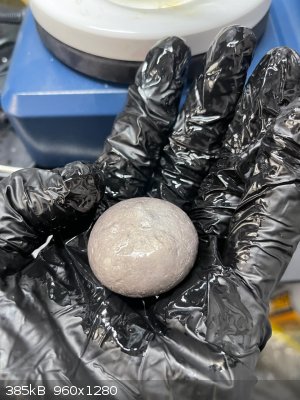Chemist1357
Harmless

Posts: 29
Registered: 26-10-2022
Member Is Offline
|
|
Semi-Successful Synthesis of Sodium
I followed the method used by NurdRage at a 2x scale: https://youtu.be/BsNoiFj3wlw?si=U34zZRGfd6MLti6O
28g of magnesium turnings
40g of NaOH granules
4g of menthol crystals
650ml paraffin oil
7.2g of starter sodium kindly donated by another SM member 
All the above were added to a 2-neck 2000ml RBF with a hose adapter and tube leading into a cylinder of paraffin oil. A temperature probe was immersed
into the 2nd neck and the temperature was set at 130c, held at that temperature, and stirred for 3 hours until the evolution of H2 gas had stopped.
The reason for this is to allow the starter sodium to destroy any water present in the NaOH otherwise it will destroy the flask at high temperature.
You don’t need the starter sodium as you can use lithium too or just sacrifice a flask.
The temperature was raised to 200c and held there for about 40 hours. Evolution of H2 gas began again and stopped at around 30 hours as paraffin oil
began climbing up the tube. After 40 hours everything was left to cool down and the solids were filtered through a kitchen sieve. There was a little
leftover Mg. The solids were then put into a flask of 300ml of 1,4 dioxane and refluxed for 2 hours. The heat was turned off, allowed to cool and the
sodium floated to the surface while the little leftover Mg sunk to the bottom. The sodium was weighed in granules being 19.6g.
The sodium was then added to a beaker of paraffin oil heated to 105c to melt it and small squirts of isopropyl alcohol were added. The sodium all
congealed into a nice ball and I played around with it in my hand. I cut it in half with a knife and observed its beautiful sheen. It is now stored in
a bottle of paraffin oil where the outside of it has turned golden from reacting with the open air and maybe any impurities in the paraffin oil.
The theoretical yield of this experiment was 22.99g of sodium. I only got 19.6g minus the 7.2 starter sodium so 12.4g was made which means a 54%
yield. Kind of disappointing as NurdRage got a 94% yield with the same method. My magnesium turnings are supposed to be quite pure so I assume it was
my hardware store NaOH which probably contained a lot of water which could have lowered the yield. Anyway, it did work and I got an element that
I’ve always wanted to see.
  
[Edited on 23-9-2023 by Chemist1357]
|
|
|
Rainwater
National Hazard
   
Posts: 925
Registered: 22-12-2021
Member Is Offline
Mood: Loving every second
|
|
I recommend heating the reagents and solvents to over 100c for an hour to help dry off any water
Be sure to protect the naoh from co2, carbonate and bicarbonate do not work for this reaction.
The extra catalyst will decrease reaction time, but consume sodium, by reusing the oil for your next run, this lose becomes a 1 time occurrence.
If you decant and filter the oil, being it to about 320c, and you will start distilling the solvent, which squeezes a little more sodium out of the
reaction but causes tar.
My I ask how did you keep that amount stirring? my stirbar struggles with this
"You can't do that" - challenge accepted
|
|
|
Chemist1357
Harmless

Posts: 29
Registered: 26-10-2022
Member Is Offline
|
|
Quote: Originally posted by Rainwater  | I recommend heating the reagents and solvents to over 100c for an hour to help dry off any water
Be sure to protect the naoh from co2, carbonate and bicarbonate do not work for this reaction.
The extra catalyst will decrease reaction time, but consume sodium, by reusing the oil for your next run, this lose becomes a 1 time occurrence.
If you decant and filter the oil, being it to about 320c, and you will start distilling the solvent, which squeezes a little more sodium out of the
reaction but causes tar.
My I ask how did you keep that amount stirring? my stirbar struggles with this |
Good advice, that would definitely improve yields. I would guess that heating the NaOH in the oven at 250c overnight would help too.
Yes the magnesium especially if you use turnings takes up a huge amount of space in the flask. Set the stir to very low rpm 80-100rpm as this helps
the stir bar turn everything slowly without being dislodged. As the reaction progresses all the magnesium slowly shrinks down and down into oil and
stirring at max rpm becomes easy.
[Edited on 24-9-2023 by Chemist1357]
[Edited on 24-9-2023 by Chemist1357]
|
|
|